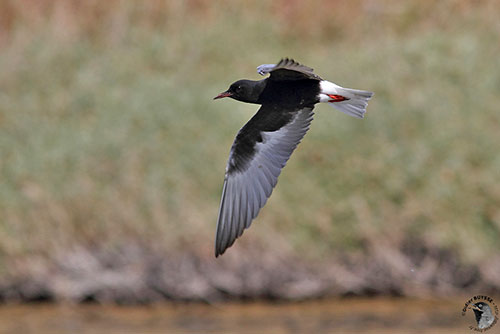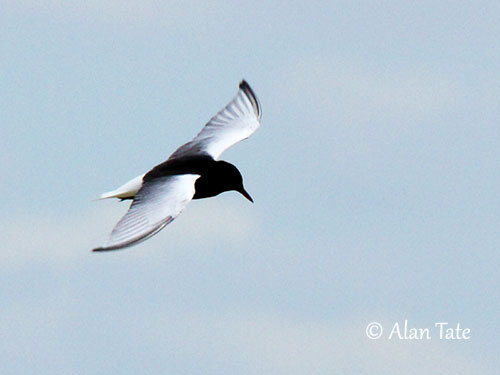
Fr: Guifette leucoptère
Ang: White-winged Tern - White-winged Black Tern
All: Weißflügel-Seeschwalbe
Esp: Fumarel Aliblanco
Ita: Mignattino alibianche
Nd: Witvleugelstern
Sd: vitvingad tärna
Photographers:
John Anderson
John Anderson Photo Galleries
Didier Buysse
Vision d’Oiseaux
Otto Plantema
Trips around the world
Alan & Ann Tate
AA Bird Photography
Text by Nicole Bouglouan
Sources :
HANDBOOK OF THE BIRDS OF THE WORLD Vol 3 by Josep del Hoyo-Andrew Elliott-Jordi Sargatal - Lynx Edicions - ISBN : 8487334202
THE HANDBOOK OF BIRD IDENTIFICATION FOR EUROPE AND THE WESTERN PALEARCTIC by Mark Beaman, Steve Madge - C. Helm - ISBN: 0713639601
BIRDS OF AFRICA SOUTH OF THE SAHARA by Ian Sinclair and Peter Ryan - Princeton University Press Princeton and Oxford - ISBN: 0691118159
GUIDE DES OISEAUX DE MER par Peter Harrison – Editeur : BROQUET Lavoie - Édition : Nouvelle nomenclature (17 février 1996) - ISBN 10 : 2890004090 - ISBN 13 : 9782890004092 – 448 pages
Wikipedia, the free encyclopaedia
Birds in backyards (Birds Australia and Australian Museum)
Biodiversity Explorer – The Web of Life in Southern Africa
White-winged Tern
Chlidonias leucopterus
Charadriiformes Order – Laridae Family
INTRODUCTION:
The White-winged Tern is a small species usually found near freshwater marshes from SE Europe to C Asia where it breeds. Its wintering areas are in Africa, S Asia and Australia, but this species is vagrant in several areas outside its usual range.
The White-winged Tern sometimes hybridizes with the very similar Black Tern. The feeding behaviour of marsh terns differs from that of the “white” terns of genus Sterna. This bird does not dive for prey but picks items while flying slowly over the water surface. It feeds mainly on aquatic insects caught in flight.
The White-winged Tern is threatened by destruction of the habitat and drainage of wetlands within the European range, and recreational activities in some other countries.
But the large population is currently stable and not globally threatened.

DESCRIPTION OF THE BIRD:
Biometrics:
Length: 23-27 cm (including tail up to 7,5 cm)
Wingspan: 63-67 cm
Weight: 54-66 g
The White-winged Tern in breeding plumage has black head, neck, back and belly, whereas rump, undertail-coverts and tail are white. The upperwing is pale grey with broad white leading edge, but lesser and median coverts are mostly white.
The underwing is pale grey, but underwing-coverts and axillaries are black.
The bill is reddish-black. The eyes are blackish-brown. Legs and feet are red.
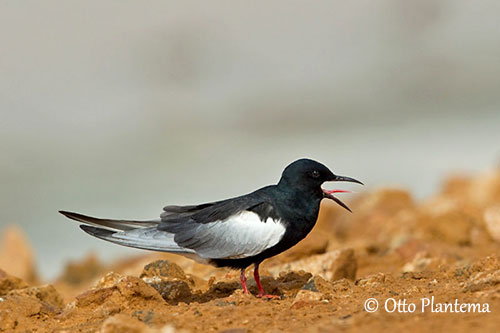
The non-breeding adult has pale grey upperparts and white head and underparts. On the head, the crown is brownish and there is a dark auricular patch.
The bill is blackish. Legs and feet are dull reddish.
The moult into breeding plumage occurs in mid-March.
Male and female are similar.
The juvenile resembles non-breeding adult, but the crown shows more extended brownish colour. On the upperparts, the blackish-brown saddle contrasts with the white rump and the pale grey upperwings. A white collar is conspicuous.
On the head, a vertical black patch behind the eye joins the dark centre of the crown. Rest of head is white.
The bill is black. Legs and feet are dull reddish-black.
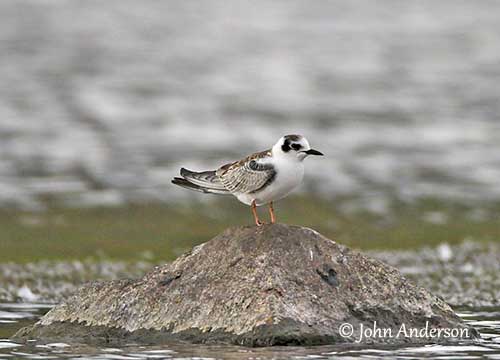
RANGE:
The White-winged Tern has extensive range from SE Europe to C Asia. It breeds in NW Italy and C and E Europe through Siberia, Transbaïkalia and N Mongolia to SE Russia and adjacent NE China. Breeding birds are reported in New Zealand.
It winters in N Africa and sub-Saharan Africa, and from S Asia to New Guinea, Australia and New Zealand.
HABITAT:
The White-winged Tern breeds near freshwater lakes, ponds and swamps with extensive emergent or fringing vegetation.
During migration and in winter, it frequents a variety of habitats such as more open lakes and rocky coasts, estuaries, coastal lagoons and mangrove swamps.
CALLS AND SONGS: SOUNDS BY XENO-CANTO
The White-winged Tern frequently gives loud, short “kek-kek” when excited or alarmed. It also produces a harsh, creaking “kesch”.

BEHAVIOUR IN THE WILD:
The White-winged Tern feeds primarily on aquatic insects such as Dipterans, Odonata and Coleopterans, and also takes terrestrial insects and spiders. It may occasionally eat small fish or tadpoles, including sardines (Limnothrissa miodon) in South Africa. However, during the dry season in this country, it takes fish trapped in small pools.
The White-winged Tern catches insects on the wing by flying slowly above water surface. It also hunts by flying 2-4 metres above water and dipping down to catch prey from the surface or just below.
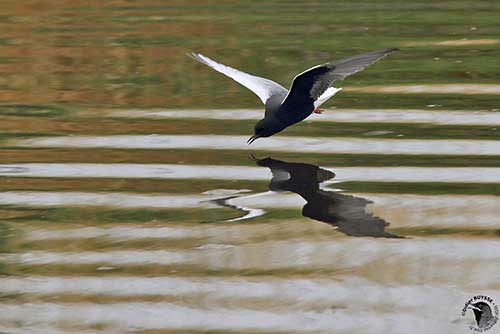

It may sometimes dive slightly below the surface, but unlike the terns of genus Sterna, it does not dive for fish but only picks items from the surface while flying.
It often roosts on emergent branches.
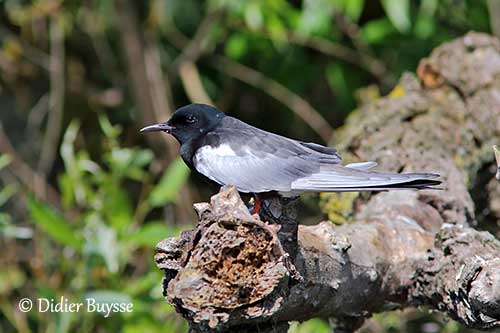
The White-winged Tern may hybridize with the Black Tern, with records from Sweden and The Netherlands.
It breeds in small monospecific colonies, but sometimes with other species. The birds select a territory and defend it. Then, they re-establish the pair-bonds or form a new pair.
Displays include courtship feeding during some days or weeks prior to the egg-laying. The birds probably perform aerial displays during which the male often flies with a fish in the bill to attract females. Copulation usually follows fish-transfer.

The White-winged Tern is migratory. European and W Asian populations leave the breeding areas between late July and late August, and winter mostly in Africa. They reach Senegal in August-September.
C and E Asian populations winter southwards to Australia and New Zealand.
They leave their wintering grounds in February/April.
This specie is vagrant in Spain, Morocco, UK, Scotland… but also in E North America and the Caribbean. It is rarer on W coast of USA and inland. There is one record in South America, in S Brazil in 2008.
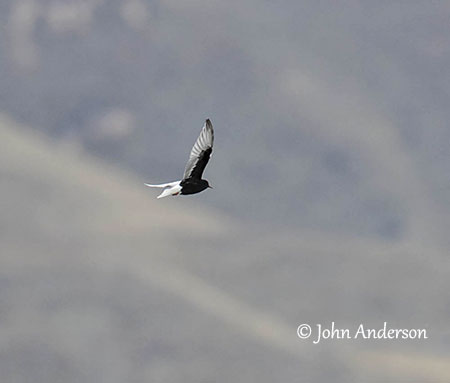
Breeding adult off
New Zealand coasts
In flight, the White-winged Tern may appear bulky. Wingbeats are shallow and leisurely. It is very agile while foraging in flight above water.
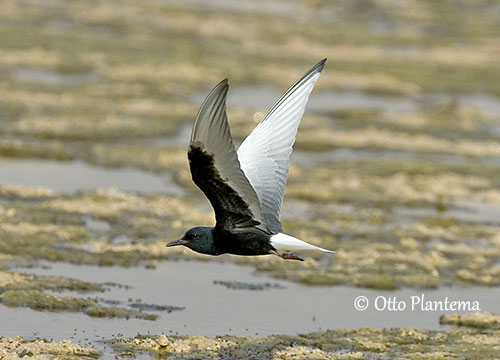
REPRODUCTION OF THIS SPECIES:
The breeding season occurs between April and August, and mainly in June.
The White-winged Tern establishes small colonies of 20-40 pairs, occasionally up to 100 pairs. They are usually monospecific colonies, but sometimes with other terns, gulls or grebe species.
The nest is a shallow cup placed on a mound of floating vegetation, usually in water 30-120 cm deep. But it may be placed on dry shore or resting on the bottom.
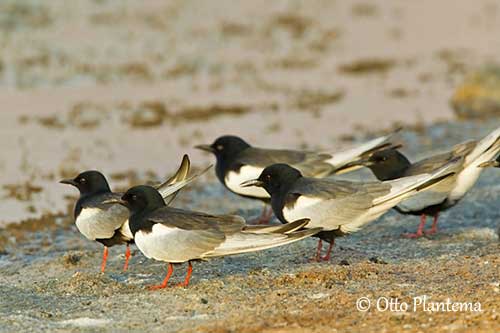
The female lays 2-3 creamy-white eggs with dark markings. The incubation lasts 18-22 days, shared by both adults. At hatching, the downy chicks have buffy upperparts with black streaks. The underparts are paler with some dark spots. The eye is surrounded by pale patch. The young are fed by both parents. They fledge 20-25 days after hatching. They can breed at 2 years old.
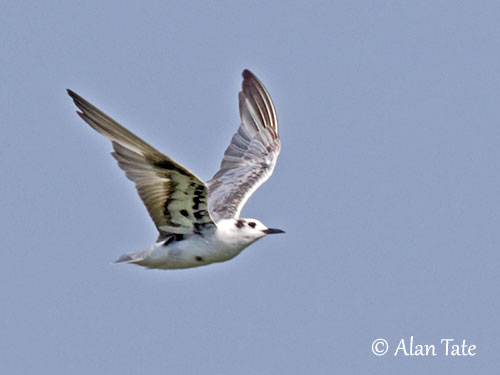
PROTECTION / THREATS / STATUS:
The White-winged Tern has wide range, but it is affected by destruction of its habitat and water regulation in wetlands. Some declines occur in Russia and the Ukraine, caused by dry breeding seasons and drainage of wetlands. Recreational activities in Poland disturb the breeding pairs.
The global population was estimated to number 3,100,000/4,000,000 individuals in 2015, whereas the European population was estimated at 133,000/347,000 mature individuals.
The trend is stable and the population is not globally threatened.
The White-winged Tern is currently evaluated as Least Concern.
